Johnson R.S. A Modern Introduction to the Mathematical Theory of Water Waves
Подождите немного. Документ загружается.

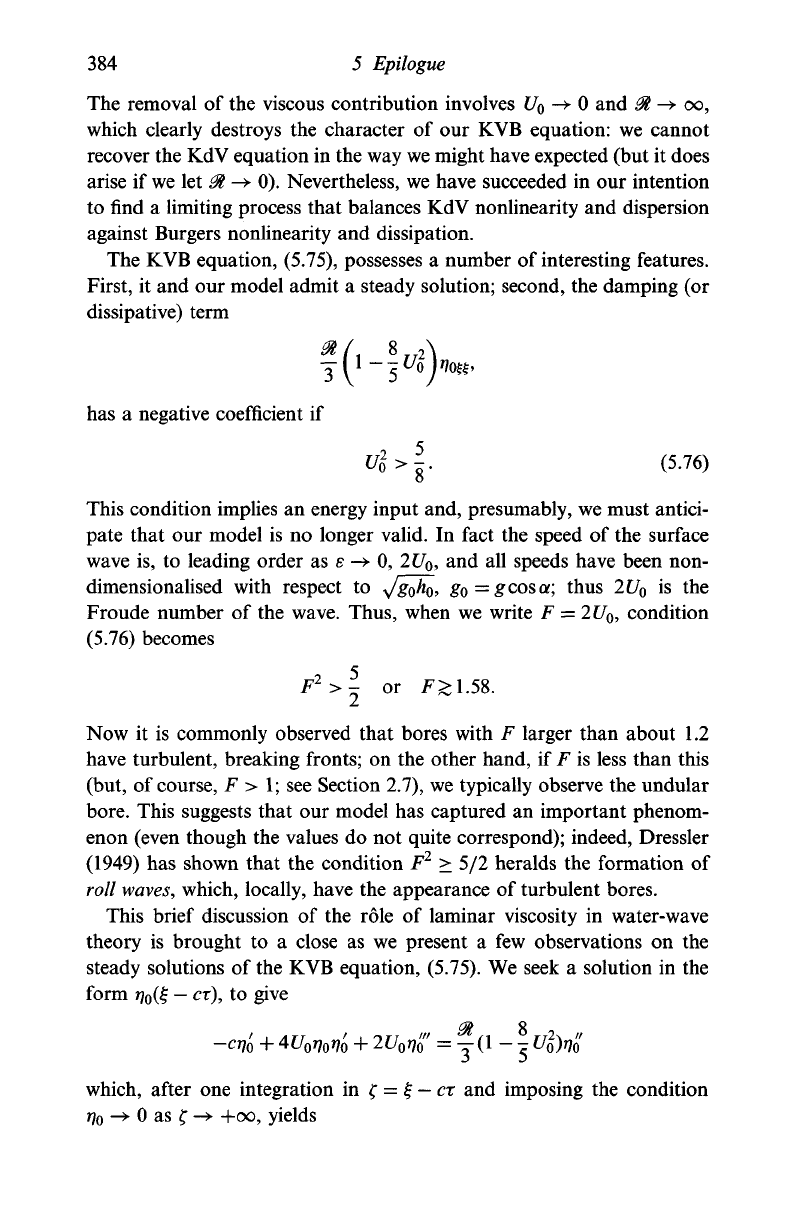
384 5 Epilogue
The removal of the viscous contribution involves U
o
-> 0 and 0t -> oo,
which clearly destroys the character of our KVB equation: we cannot
recover the KdV equation in the way we might have expected (but it does
arise if
we
let 0t -> 0). Nevertheless, we have succeeded in our intention
to find a limiting process that balances KdV nonlinearity and dispersion
against Burgers nonlinearity and dissipation.
The KVB equation, (5.75), possesses a number of interesting features.
First, it and our model admit a steady solution; second, the damping (or
dissipative) term
has a negative coefficient if
Co
>f.
(5.76)
This condition implies an energy input and, presumably, we must antici-
pate that our model is no longer valid. In fact the speed of the surface
wave is, to leading order as e -> 0,
2UQ,
and all speeds have been non-
dimensionalised with respect to y^o^o* g
0
= gcosa; thus 2U
0
is the
Froude number of the wave. Thus, when we write F
—
2U
0
, condition
(5.76) becomes
F
2
>\ or F>1.58.
Now it is commonly observed that bores with F larger than about 1.2
have turbulent, breaking fronts; on the other hand, if F is less than this
(but, of
course,
F > 1; see Section 2.7), we typically observe the undular
bore.
This suggests that our model has captured an important phenom-
enon (even though the values do not quite correspond); indeed, Dressier
(1949) has shown that the condition F
2
> 5/2 heralds the formation of
roll
waves, which, locally, have the appearance of turbulent bores.
This brie
f discussion of the role of laminar viscosity in water-wave
theory is brought to a close as we present a few observations on the
steady solutions of the KVB equation, (5.75). We seek a solution in the
form 7/
0
(£
—
cr), to give
-crjo
+
^U
o
r]
O
rjo
+
2U
0
r]Q
f
=
—
(1
- -
C/o)*7o
which, after one integration in f =
£
—
ex and imposing the condition
rj
0
-> 0 as f
->
+oo, yields

Applications to the propagation of gravity waves 385
-cr/o
+
2U
O
T,
2
O
+
2U
o
r,o
=
j (1
-1 ^
This equation is conveniently normalised by introducing the
transformation
to give
rjl -
rj
0
+ i/o = ^o> (5.77)
where
In the form (5.77), we then have
770
-> 1 as f -> —00,
if solutions exist for which this is possible, which certainly requires
A
> 0
i.e. C/Q < 5/8. It is a
asymptotic behaviours
i.e.
C/Q
< 5/8. It is an elementary exercise (see Q5.15) to seek the
j
0
p(a£), f -• +00
and
ri
o
~l-bexp(j8f), f -> -00,
and to find that
The choice
of the
sign
in a
ensures that
rj
0
-> 0 as f ->
H-oo;
in ^,
either
sign
is
possible
(and it is
clear here that
we
must have
k > 0), but the
profile
as f ->
— 00
may be
either monotonic
(A > 2) or
oscillatory
(0
<
A
< 2).
Thus equation (5.77) will allow either
a
monotonic transition
through
the
jump
(a
non-turbulent classical jump)
or an
oscillation about
f7o
= l (th
e
undular bore).
The
interpretation
is
quite simply that larger
A
means larger dissipation (mainly
in the
neighbourhood
of f = 0), so no
wave
is
required
to
transport
the
excess energy away.
For
smaller
A, the
wave
is
needed
to
carry
the
surplus energy away from
the
front.
A number
of
interesting properties
of the
steady
KVB
equation
can be
explored
and
exploited;
see
Q5.16—Q5.19.
We
conclude
by
presenting
two
solutions
of the KVB
equation, (5.77),
in
Figure
5.7;
these
are
based
on
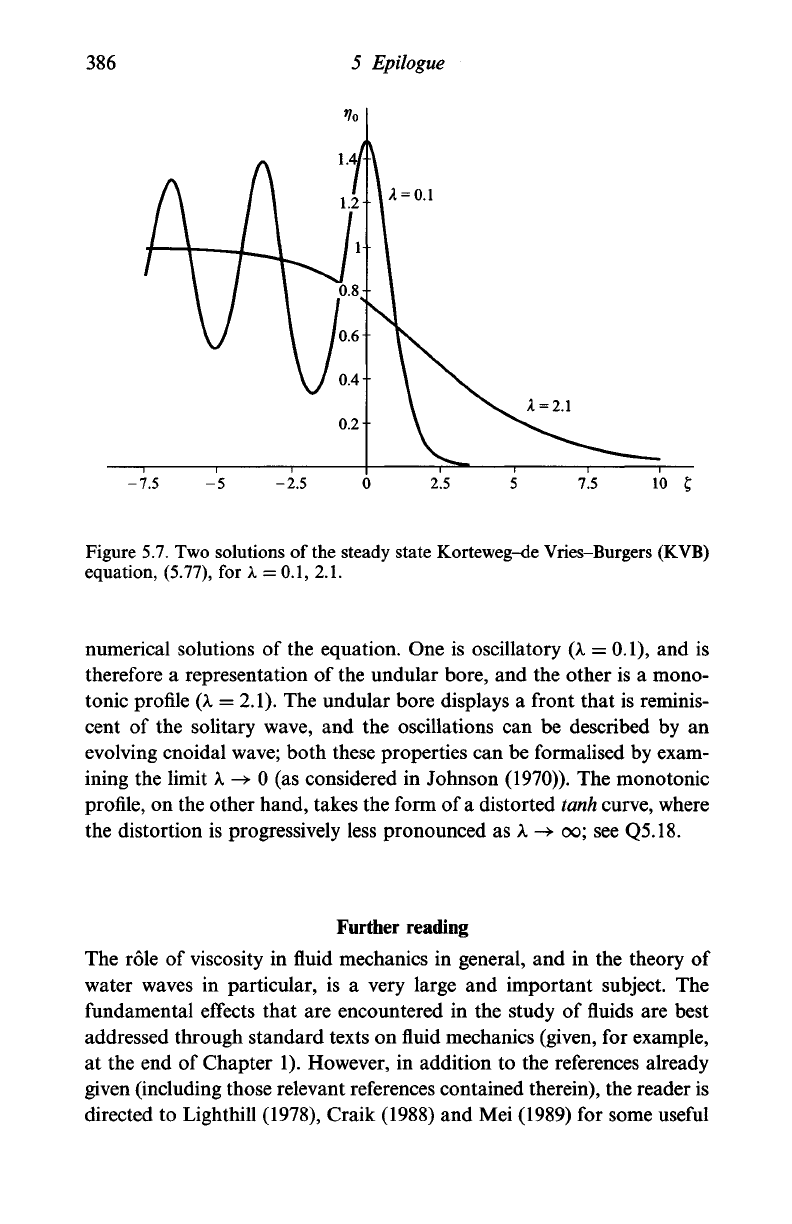
386
-7.5
-5
-2.5 2.5 7.5
io
Figure 5.7. Two solutions of the steady state Korteweg-de Vries-Burgers (KVB)
equation, (5.77), for
X
=
0.1,
2.1.
numerical solutions of the equation. One is oscillatory (A = 0.1), and is
therefore a representation of the undular bore, and the other is a mono-
tonic profile (A = 2.1). The undular bore displays a front that is reminis-
cent of the solitary wave, and the oscillations can be described by an
evolving cnoidal wave; both these properties can be formalised by exam-
ining the limit
X
-> 0 (as considered in Johnson (1970)). The monotonic
profile, on the other hand, takes the form of
a
distorted
tank
curve, where
the distortion is progressively less pronounced as
A
-> oo; see Q5.18.
Further reading
The role of viscosity in fluid mechanics in general, and in the theory of
water waves in particular, is a very large and important subject. The
fundamental effects that are encountered in the study of fluids are best
addressed through standard texts on fluid mechanics (given, for example,
at the end of Chapter 1). However, in addition to the references already
given (including those relevant references contained therein), the reader is
directed to Lighthill (1978), Craik (1988) and Mei (1989) for some useful

Exercises 387
and fairly up-to-date material on viscous dissipation in wave propaga-
tion. The text by Debnath (1994) also touches on some of these ideas.
Exercises
Q5.1 Dispersion relation: large R. Consider the dispersion relation,
(5.21),
in the limit R -> oo at fixed 8k, and hence obtain result
(5.22):
(8k)
1
"
]
cosh
5/4
5A:sinh
3/4
5/cj'
Q5.2
Dispersion
relation:
8k = 0(1
/R).
Show that the result obtained
in Q5.1 is not uniformly valid, as 8k -* 0, where 8kR = O(l).
Hence obtain the equations that describe the leading approxima-
tion to the dispersion relation, (5.21), in the limit R -> oo at 8kR
fixed.
[Note: these equations cannot be solved in closed form.]
Q5.3
Dispersion
relation:
small 8k. Consider the dispersion relation,
(5.21),
in the limit 8k -> 0 at fixed R, and hence show that
co
~ -i8k
2
R/3
(where the real part of
co
turns out to be exponentially small).
[This case, which is essentially a high-viscosity limit, shows
that (at this order) there is no
propagation,
only decay. As an
additional exercise, you may show that the expression obtained
in Q5.2 agrees, for 8k -» oo, with that given in Q5.1 as 8k -» 0,
and that there is agreement between Q5.2 and Q5.3 for 8k -> 0.]
Q5.4
Dispersion
relation with surface
tension.
Repeat the calculation
presented in Section
5.2.1,
but with the surface pressure condi-
tion adjusted to accommodate the effects of surface tension,
namely
p — r\ w
z
=
—8
2
W
Q
r)
xx
on z = 1;
R
cf. Section
2.1.
Hence obtain the dispersion relation, with surface
tension, which corresponds to that given in equation (5.21).
Q5.5 A model boundary layer problem. Obtain the solution of the
ordinary differential equation
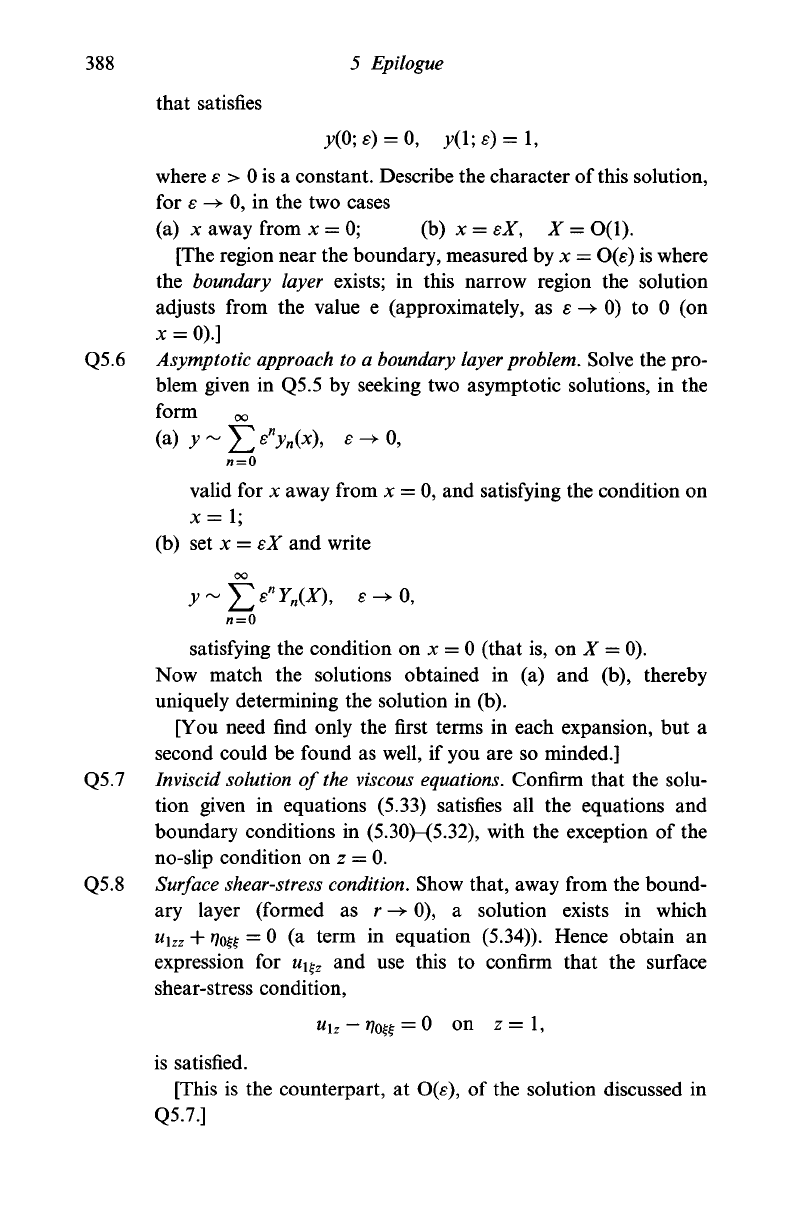
388 5 Epilogue
that satisfies
where s > 0 is a constant. Describe the character of this solution,
for e -> 0, in the two cases
(a) x away from ;c = 0; (b) x = eX, X = O(l).
[The region near the boundary, measured by x = O(e) is where
the boundary layer exists; in this narrow region the solution
adjusts from the value e (approximately, as s -> 0) to 0 (on
* = 0).]
Q5.6 Asymptotic approach to a boundary layer problem. Solve the pro-
blem given in Q5.5 by seeking two asymptotic solutions, in the
form oo
(a) >>
valid for x away from x = 0, and satisfying the condition on
x=l;
(b) set x = sX and write
oo
satisfying the condition on x = 0 (that is, onl = 0).
Now match the solutions obtained in (a) and (b), thereby
uniquely determining the solution in (b).
[You need find only the first terms in each expansion, but a
second could be found as well, if you are so minded.]
Q5.7 Inviscid solution of the viscous equations. Confirm that the solu-
tion given in equations (5.33) satisfies all the equations and
boundary conditions in (5.30)-(5.32), with the exception of the
no-slip condition on z = 0.
Q5.8 Surface shear-stress condition. Show that, away from the bound-
ary layer (formed as r^ 0), a solution exists in which
u
\zz +
Vog
= 0 (a term in equation (5.34)). Hence obtain an
expression for u^
z
and use this to confirm that the surface
shear-stress condition,
U\
z
—
?7o£f
=
0 on z = 1,
is satisfied.
[This is the counterpart, at O(e), of the solution discussed in
Q5.7.]
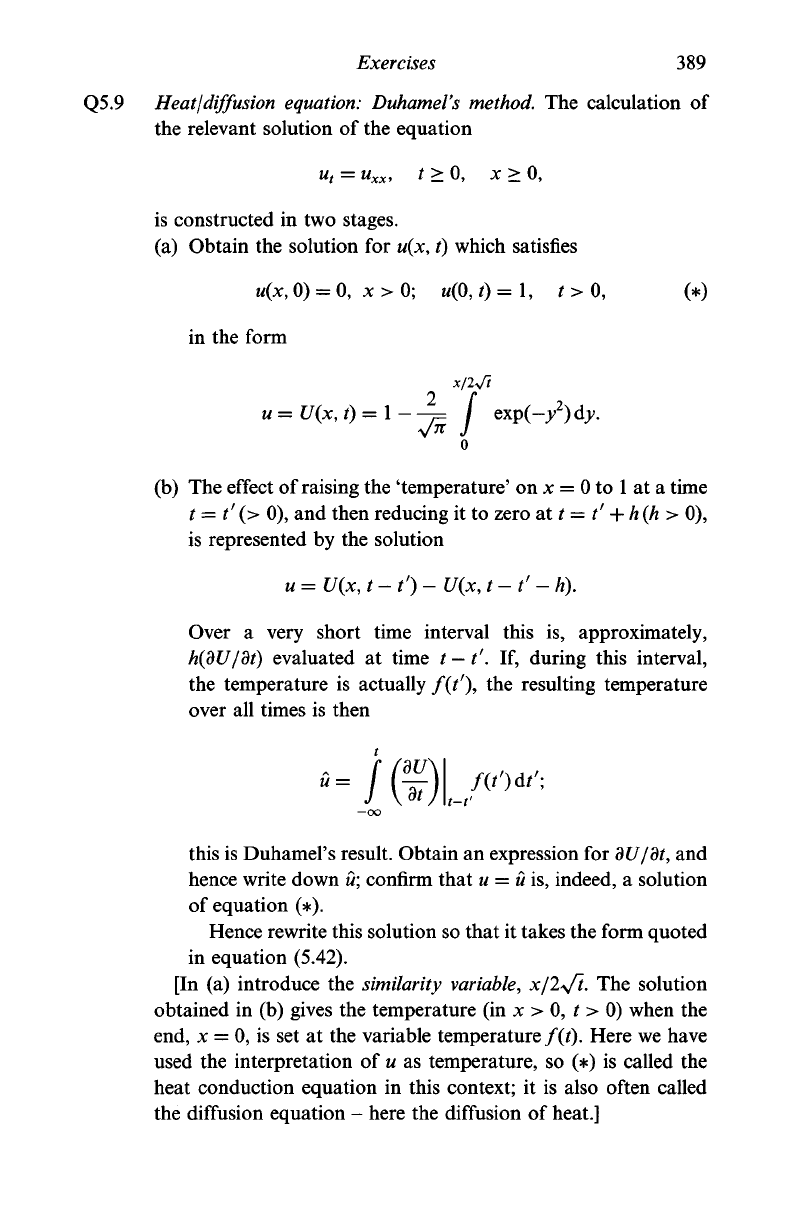
Exercises 389
Q5.9 Heat I diffusion
equation:
Duhamel's
method.
The calculation of
the relevant solution of the equation
u
t
= u
xx
,
*
> 0, x > 0,
is constructed in two stages.
(a) Obtain the solution for u(x, i) which satisfies
u(x, 0) = 0, x > 0;
w(0,
0 = 1. t > 0, (*)
in the form
u
=
U(x,
t)
= l--j= j exp(-/)dj.
(b) The effect of raising the 'temperature' on x = 0 to
1
at a time
t = t' (> 0), and then reducing it to zero dXt = t' + h(h> 0),
is represented by the solution
u
=
U(x,
t-t')-
U(x, t-t
f
- h).
Over a very short time interval this is, approximately,
h(dU/dt) evaluated at time t
—
t'. If, during this interval,
the temperature is actually f(t\ the resulting temperature
over all times is then
this is Duhamel's result. Obtain an expression for dU/dt, and
hence write down
u;
confirm that u = u is, indeed, a solution
of equation (*).
Hence rewrite this solution so that it takes the form quoted
in equation (5.42).
[In (a) introduce the similarity
variable,
x/2^~t. The solution
obtained in (b) gives the temperature (in x > 0, t > 0) when the
end, x = 0, is set at the variable temperature/(0- Here we have
used the interpretation of u as temperature, so (*) is called the
heat conduction equation in this context; it is also often called
the diffusion equation - here the diffusion of heat.]

390 5 Epilogue
Q5.10 An
integral
identity.
Show that
and evaluate this integral for the
choice/(JC)
= exp(—ax), where
a(> 0) is a real constant.
Q5.ll
Modulation
of
the
solitary
wave.
Follow the procedure described
in equation (5.49) et
seq.,
but start by multiplying this equation
by
r]
Q
.
Hence obtain the corresponding expression for c(T).
[This derivation uses the 'conserved' density
rjl,
rather than
rj
0
as given in the text. You might wish to obtain numerical esti-
mates for the integrals that appear in these two formulae; the two
expressions for c(T) should, of course, be identical.]
Q5.12 Propagation of the modulated solitary wave. The
(nondimensional) speed of
the
solitary wave, in the characteristic
frame, is
where a (> 0) is a constant. Obtain an expression for the char-
acteristic variable (£) associated with the modulated solitary
wave; see equations (5.24).
Q5.13 Asymptotic
behaviour
of
the
bore.
Obtain an asymptotic solution
of the equation
(see equation (5.54)), in the form
ri~ae-
ax
+ be-
2a
\ x -> +oo.
Determine the relations between c, X, a, b and a, and compare
this behaviour with equation (2.165) et
seq.
and
Q2.63.
[The special case considered in Q5.10 will prove useful here.
Note that a and a could be related if the front of the wave were
to be like a solitary wave.]
Q5.14
Undular
bore:
perturbation pressure
at
O(e).
Obtain the pressure
term p
x
from equations (5.67)—(5.71), making use of the results
given in equations (5.72)-(5.74).
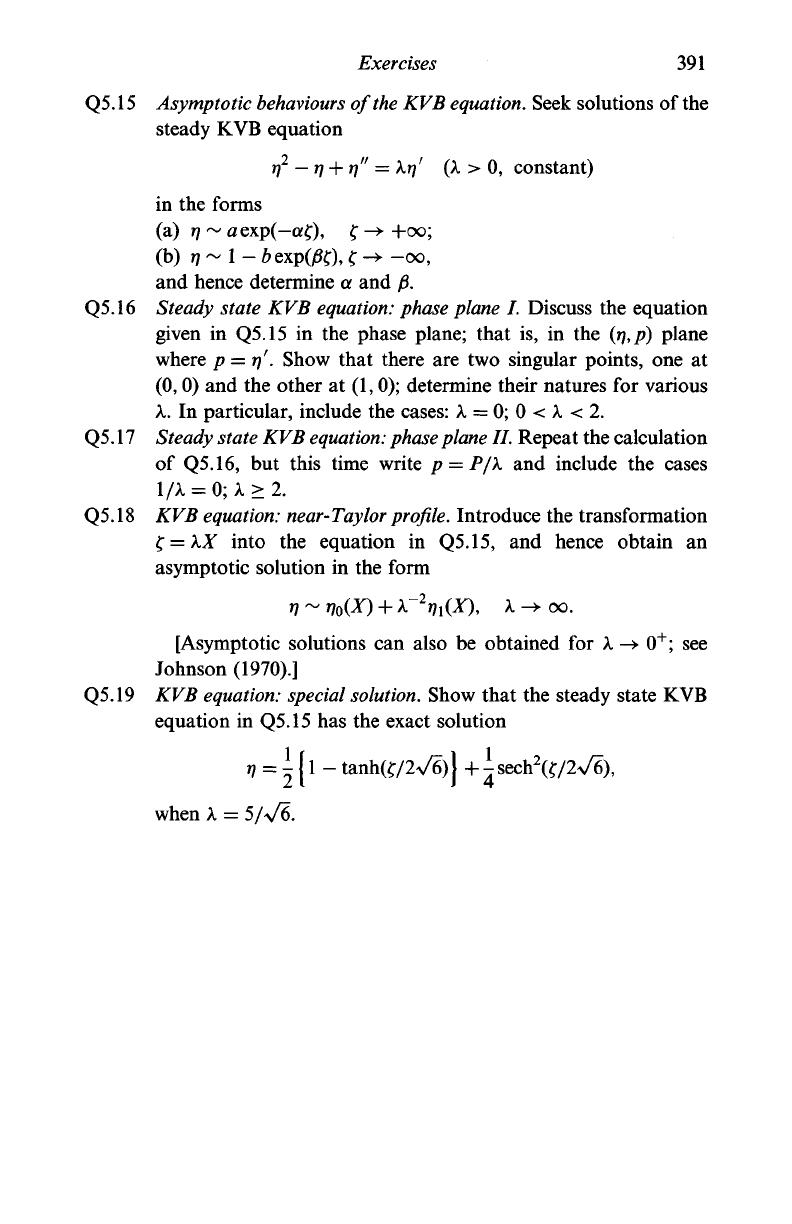
Exercises 391
Q5.15 Asymptotic
behaviours
of
the
KVB equation. Seek solutions of the
steady KVB equation
rj
2
-rj + rj" = Xrj
f
(X > 0, constant)
in the forms
(a)
rj
~
a
exp(-af), f -• +00;
(b) ij~l-&exp(j8?). ?"•-<»,
and hence determine a and jff.
Q5.16 Steady state KVB
equation:
phase plane
I. Discuss the equation
given in Q5.15 in the phase plane; that is, in the (rj,p) plane
where p = rj
f
. Show that there are two singular points, one at
(0,0) and the other at (1,0); determine their natures for various
X. In particular, include the cases:
A.
= 0; 0 <
X
< 2.
Q5.17 Steady state KVB
equation: phase
plane
II. Repeat the calculation
of Q5.16, but this time write p = P/X and include the cases
1A = 0; X > 2.
Q5.18 KVB equation:
near-Taylor
profile.
Introduce the transformation
t;
= XX into the equation in Q5.15, and hence obtain an
asymptotic solution in the form
[Asymptotic solutions can also be obtained for X -> 0
+
; see
Johnson (1970).]
Q5.19 KVB
equation:
special
solution.
Show that the steady state KVB
equation in Q5.15 has the exact solution
rj
=
X
-
j
1
- tanh(f/2V6)} + \sech
2
(?/2V6),
when X = 5/V6.

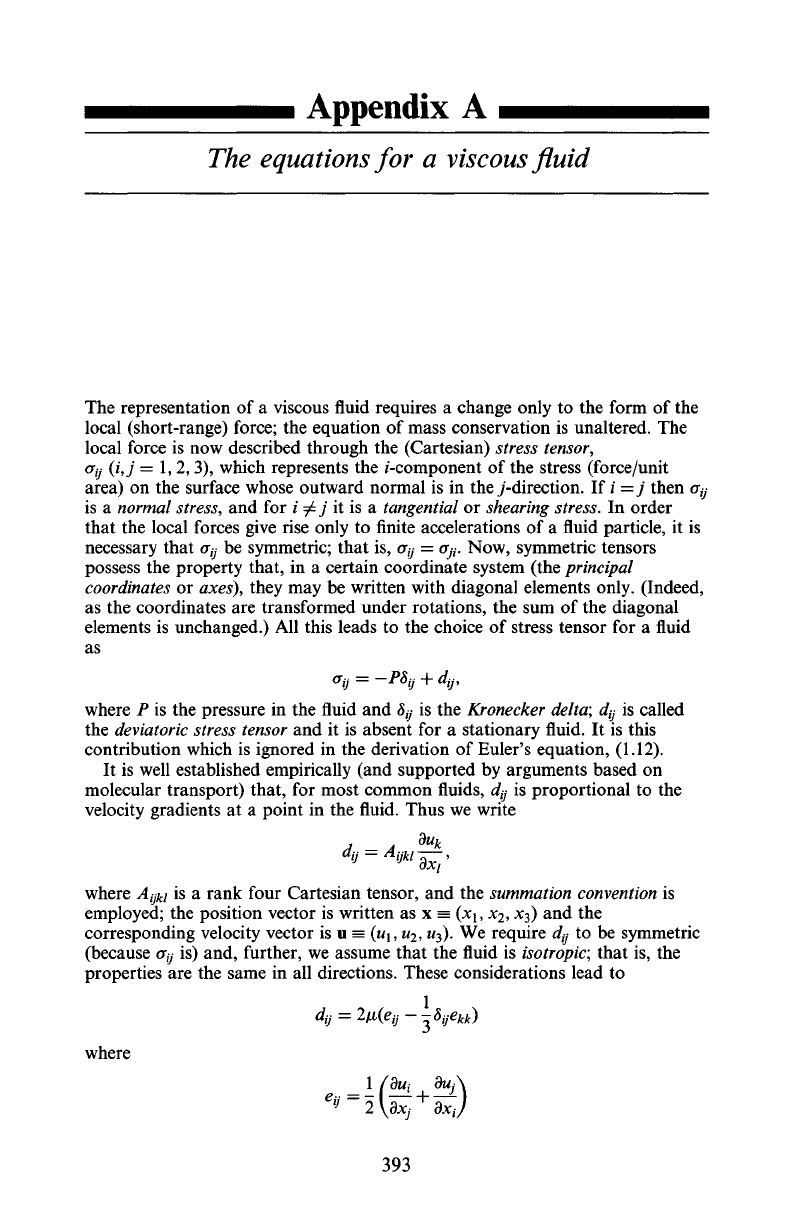
Appendix A
The equations for a viscous fluid
The representation of a viscous fluid requires a change only to the form of the
local (short-range) force; the equation of mass conservation is unaltered. The
local force is now described through the (Cartesian) stress tensor,
G
t
j
(ij =1,2, 3), which represents the /-component of the stress (force/unit
area) on the surface whose outward normal is in
the y-direction.
If i =j then a^
is a
normal
stress,
and for i ^j it is a
tangential
or
shearing
stress.
In order
that the local forces give rise only to finite accelerations of a fluid particle, it is
necessary that ay be symmetric; that is, a
tj
= a». Now, symmetric tensors
possess the property that, in a certain coordinate system (the
principal
coordinates
or
axes),
they may be written with diagonal elements only. (Indeed,
as the coordinates are transformed under rotations, the sum of the diagonal
elements is unchanged.) All this leads to the choice of stress tensor for a fluid
as
a
tj
= -P8
t
j + d^
where P is the pressure in the fluid and 8
tj
is the
Kronecker
delta;
dy is called
the
deviatoric stress tensor
and it is absent for a stationary fluid. It is this
contribution which is ignored in the derivation of Euler's equation, (1.12).
It is well established empirically (and supported by arguments based on
molecular transport) that, for most common fluids, d
tj
is proportional to the
velocity gradients at a point in the fluid. Thus we write
where
A
ijk
i
is a rank four Cartesian tensor, and the
summation convention
is
employed; the position vector is written as x = (x\, x
2
, x
3
) and the
corresponding velocity vector is u = (u\, u
2
,
M3).
We require
dg
to be symmetric
(because
G
tj
is) and, further, we assume that the fluid is
isotropic;
that is, the
properties are the same in all directions. These considerations lead to
1
y y
3
where
6ij
" 2 \dxj ' dx
t
393
